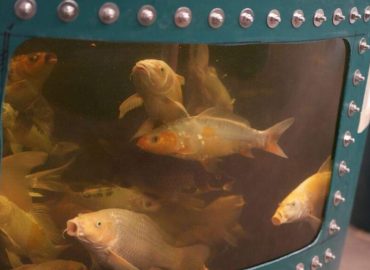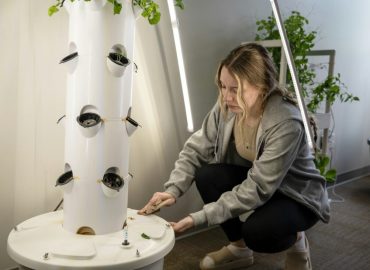Hydroponic Hot Peppers Part Two
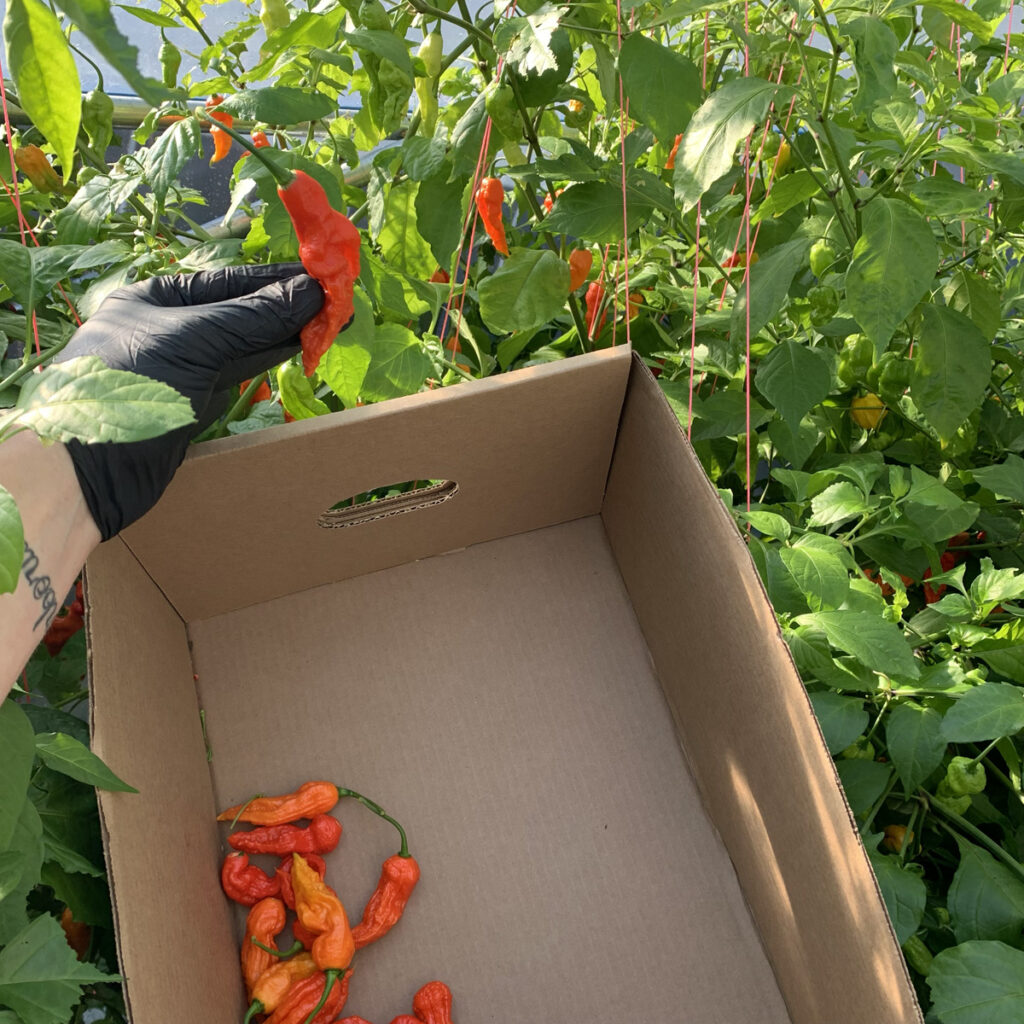
Hydroponic Hot Peppers Part Two
Exotic Capsicum Feeding, Transplant & Growth
PART ONE | HERE |
Hydroponic hot peppers are fun to grow and can pack a lot of heat without a lot of work versus conventional growing methods. Hydroponics growing keeps exotic Capsicum varieties (capsicum chinese) like Ghost Peppers, Reapers, Scorpions, Habaneros and Thai Chilies in constant supply of clean water, balanced nutrients and oxygen at the roots.
Hot peppers harvested from tidy hydroponic set ups can avoid harvest contaminants that can hurt quality, shelf life and create problems in processing, for example when making hot sauce or drying hot peppers for later use.
Up top, this makes for really healthy plants that resist common stresses better and often producing more fruits in less space. Additionally, the plants, fruits and growing area are easier to keep clean and hygienic. Hot peppers harvested from tidy hydroponic set ups can avoid harvest contaminants that can hurt quality, shelf life and create problems in processing, for example when making hot sauce or drying hot peppers for later use.
In Part One, we discussed a basic overview of the process, the types of results we could expect and how to get started from sourcing seeds to germination and early seedling development.
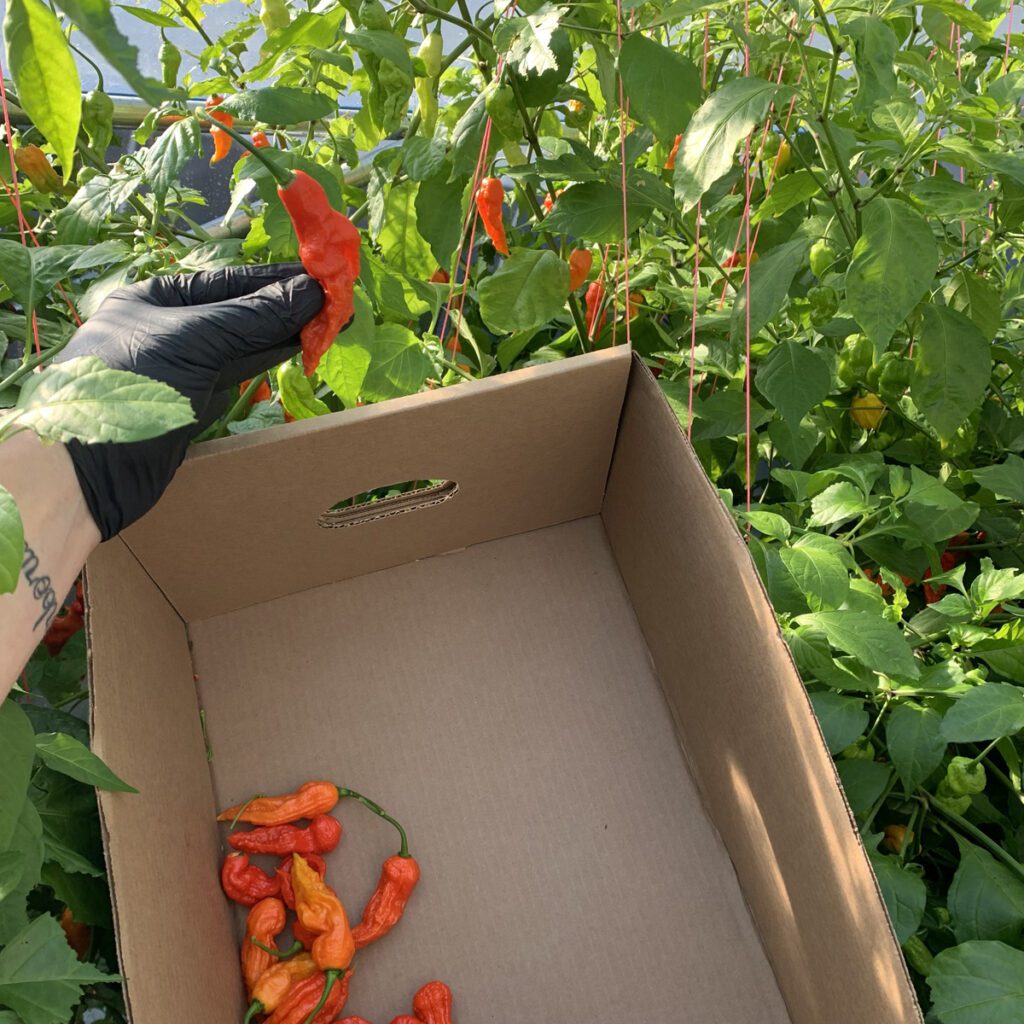
harvesting hydroponic ghost peppers
One of the great things about hydroponic growing is that no planting medium is necessary in water culture systems like RDWC, DWC, NFT and aeroponics–this saves on reoccurring expenses, mess and labor. However, soilless cultivation is still “hydroponic” and offers advantages over traditional soil growing methods because growth medias can be tailored for the type of crop and it’s easier to manage moisture levels automatically. Rockwool, coco coir and soilless blends are typically of very consistent quality and should be free of pathogens, weed seeds or insects–these work great for growing hydroponic hot peppers. Note that in water culture systems, fertilizer and water use are typically reduced versus soilless or traditional growing methods. This is because water culture methods feed the plant more directly through bare roots rather than feeding the media first which then in turn feeds the plant.
Feeding Hydroponic Hot Peppers
So, now that our exotic hot pepper genetics have become established seedlings with their first set of “true leaves” (leaves that form after cotyledon development) we can start to feed them with nutrients and transplant them for more intensive growing conditions.
Use a complete fertilizer intended for hydroponics. We recommend keeping your nutrient solution and root zone as sterile as possible, avoiding organic ingredients. While organics may get along in hydroponics for a period, contamination is likely, especially overtime and in warm conditions where hot pepper plants are most likely to thrive.
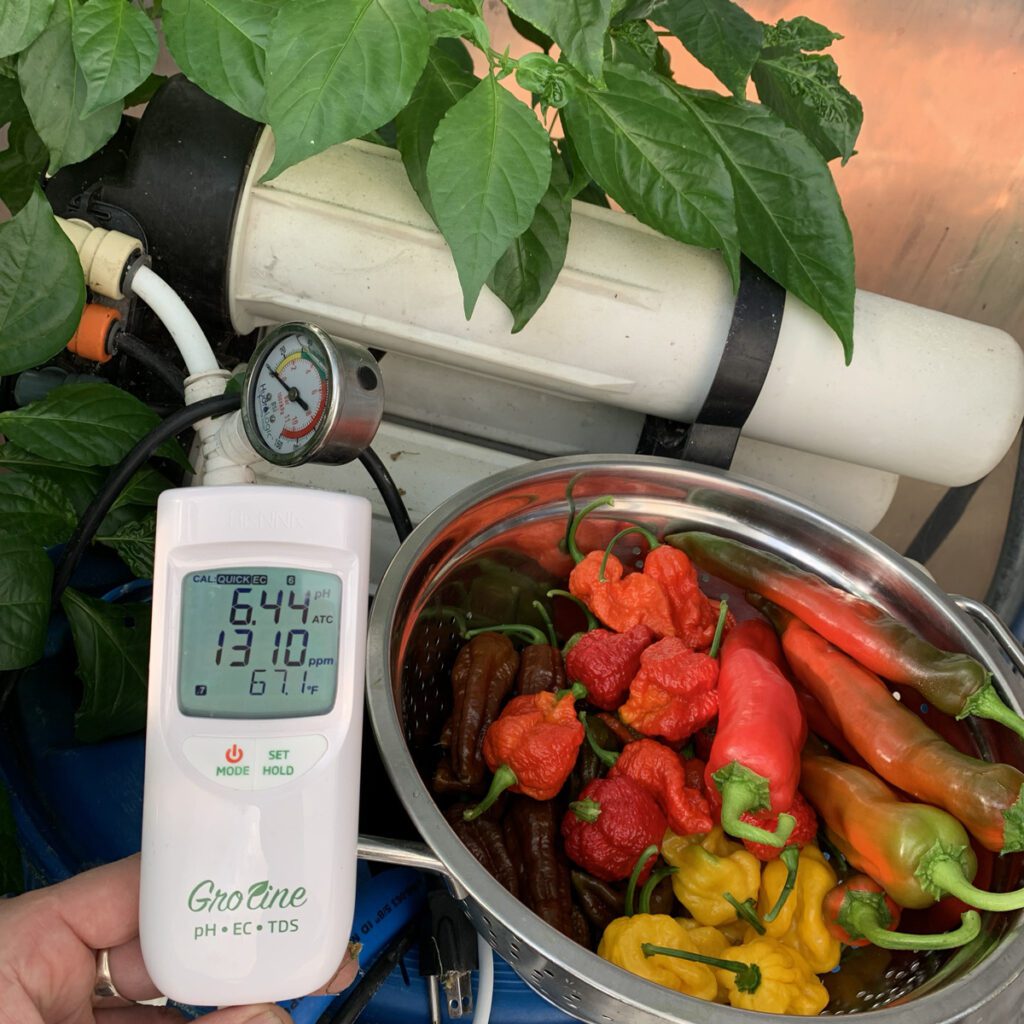
filtered water and hydroponic nutrients produce outstanding fruits
Dutch style A&B base fertilizers like Cultured Solutions are a good value and offer excellent performance. Three part hydroponic nutrients and even one part complete soluble powders are also good choices. You don’t need anything overly complicated for success. In fact, keeping it simple helps ensure healthy plants and is easier from both a practical and financial standpoint.
For early green growth (shoots, leaves, roots) in hydroponic hot peppers using a fertilizer with ample Nitrogen (N), low Phosphorous (P), elevated Potassium (K), and abundant Calcium (Ca), Magnesium (Mg) and Iron (Fe) is recommended. Naturally, the fertilizer should be 100% complete, meaning it contains ALL the necessary elements required by higher plants–the ones we mention here are of particular interest for early development, as they are required in greater abundance in this phase.
Hot Pepper Feed Tip, Early Growth: start with 1/8 to 1/4 strength fertilizer strength or follow a feeding program, gradually working feed strengths to higher levels. In soilless methods 500-700 PPM (around 0.7 to 1.0 EC) is a good starting point. In highly oxygenated setups like DWC or RDWC using filtered water, 250-350 PPM (0.3 to 0.5 EC) is typically a good baseline to start with. For vegetative growth, ie before flowering starts plants can be fed up to 1200 PPM in soilless or 800 PPM in water culture under bright lighting conditions once sufficiently established. Very dark foliage with browning leaf tips is a sign you are overfeeding a particular variety; so it’s better to start low and gradually work up to high nutrient concentrations.
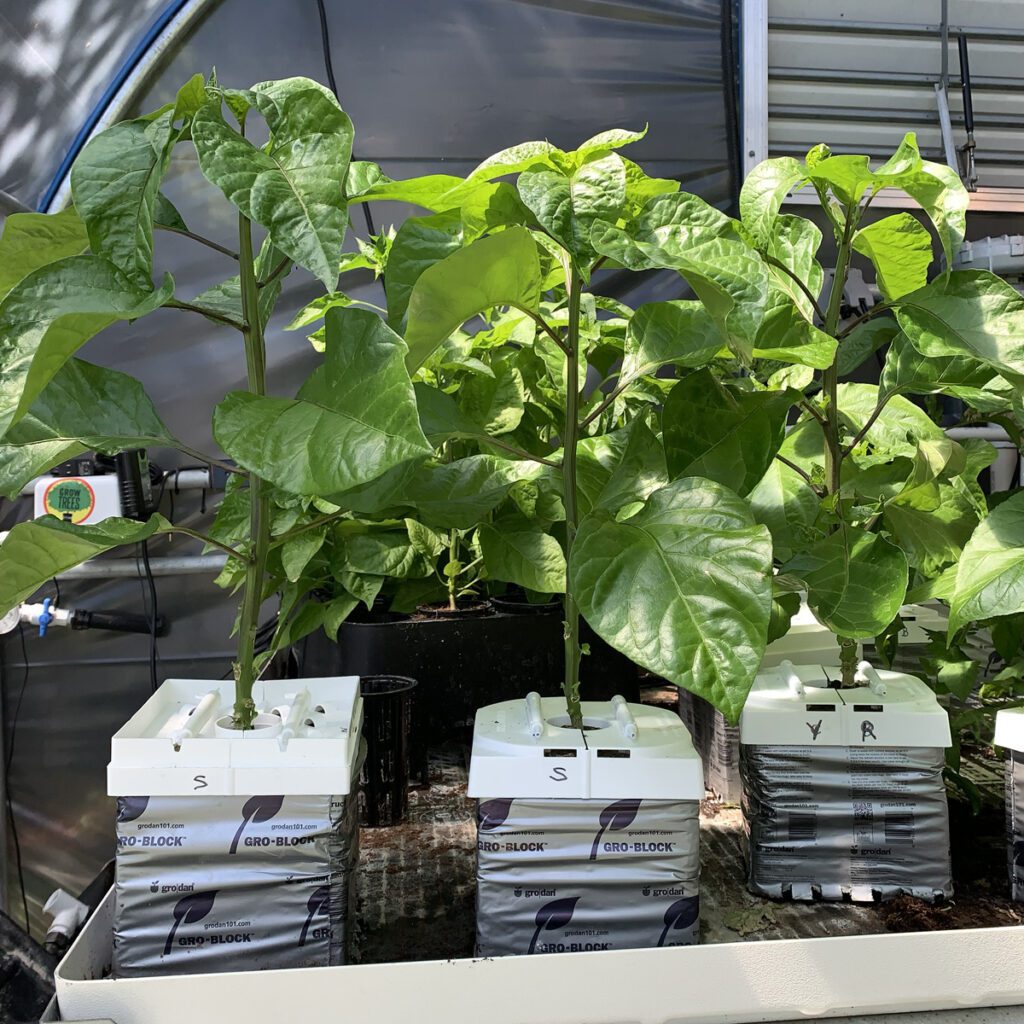
Capsicum in vegetative growth
As your hydroponic hot peppers begin to transition into flowering and fruiting they will benefit from higher concentrations of nutrients. Additionally, they will also benefit from a slight reduction in Nitrogen (N) levels, with a slight increase in Phosphorous (P) and a significant increase in Potassium (K). Calcium is vital during early flowering in fruit crops like peppers. If calcium is in short supply or not available to plants, blossoms simply drop off the plant. Without pollination of healthy flowers, there will be no fruit! Sometimes a foliar application of a calcium-magnesium supplement can remedy this situation while the grower gets fertility in the root zone back in check.
Hot Pepper Feed Tip, Flowering to Ripening: Depending on the variety, most hydroponic hot peppers will enjoy stronger crop feeding levels during flowering. In soilless methods, peak feed strengths may reach up to 1800 PPM with care. Using water culture growing methods up to 1200 PPM may be used to stimulate sturdy stems and thick fleshed fruits that develop a lot of serious heat and flavor. While it may seem counterintuitive, spiking the nutrient strength up higher (+%50 over recommended fruiting strengths) once lots of fruits have started to ripen will promote a faster finish and more even ripening in the crop. Lower nutrient concentrations during ripening can slow down the process–with the grower running the risk the season will end before all the fruits have vine ripened.
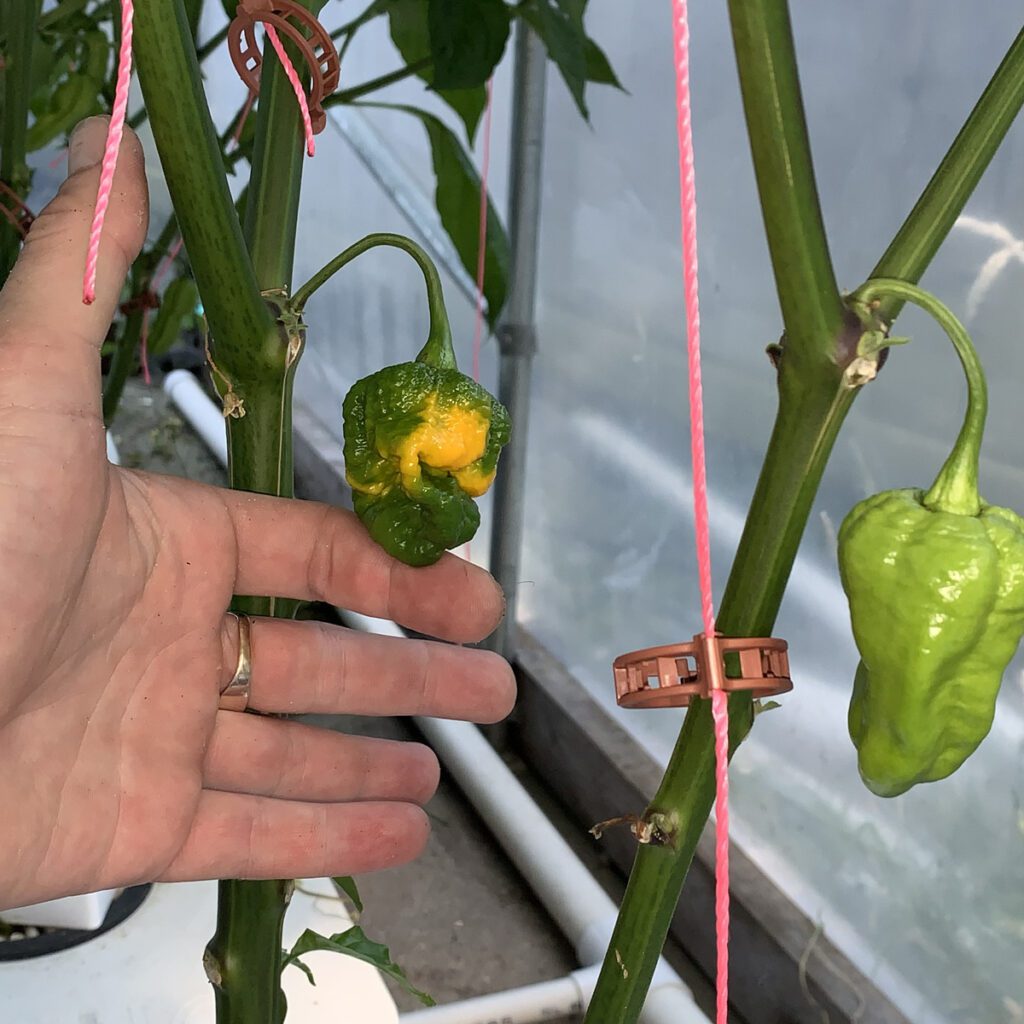
these hydroponic yellow reaper peppers are starting to ripen
Transplanting Hydroponic Hot Peppers
While the optimal module, bucket, pot or cube size will vary with each hot pepper variety relative to cropping time, here are some general recommendations growers may find handy
Rockwool: A Six Inch Hugo Block can support a fairly large hot pepper plant, up to three or four feet tall (requires frequent irrigation daily)
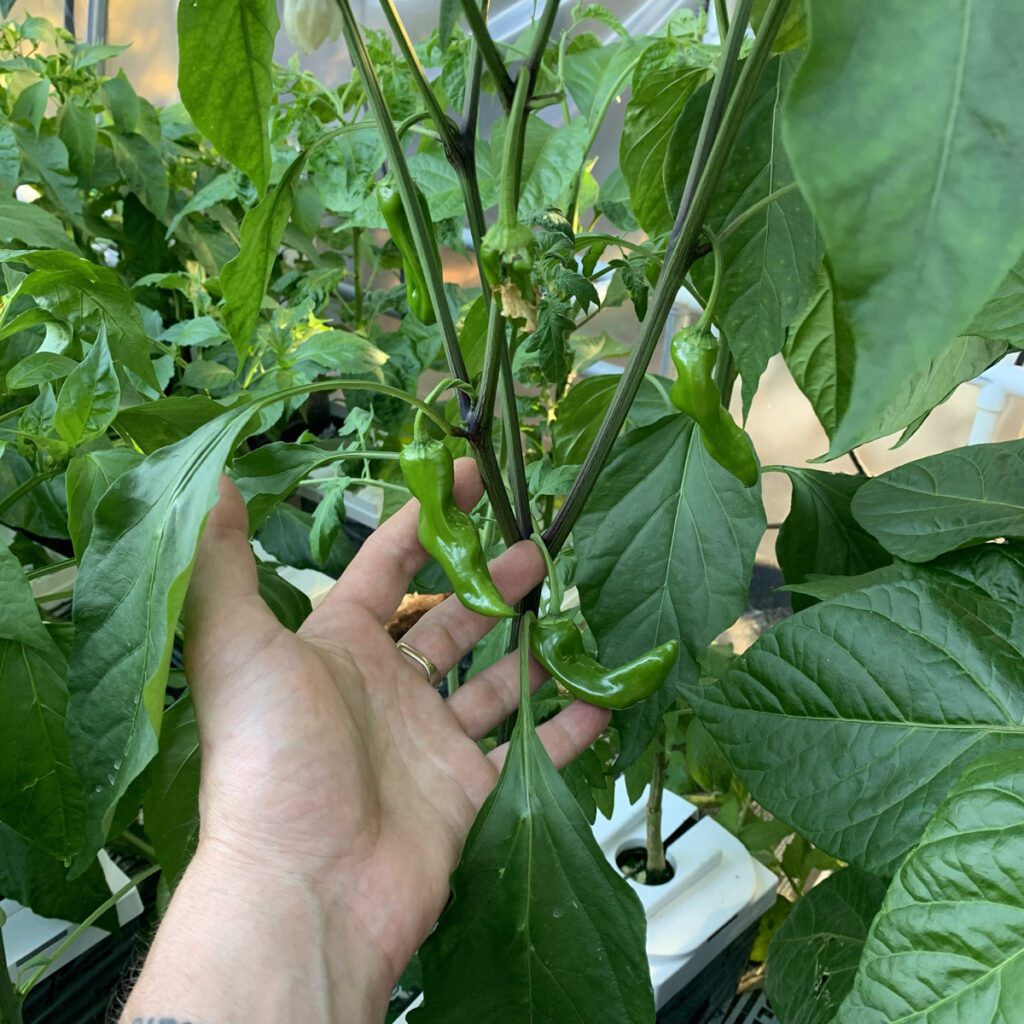
Ample sized hot pepper plants and healthy fruits in a six inch Rockwool block
Coco Coir: A three to five gallon aeration pot with high quality coco coir will keep a three to four foot hot pepper plant healthy and with loads of fruits, requiring less irrigation frequency than a six inch rock wool block.
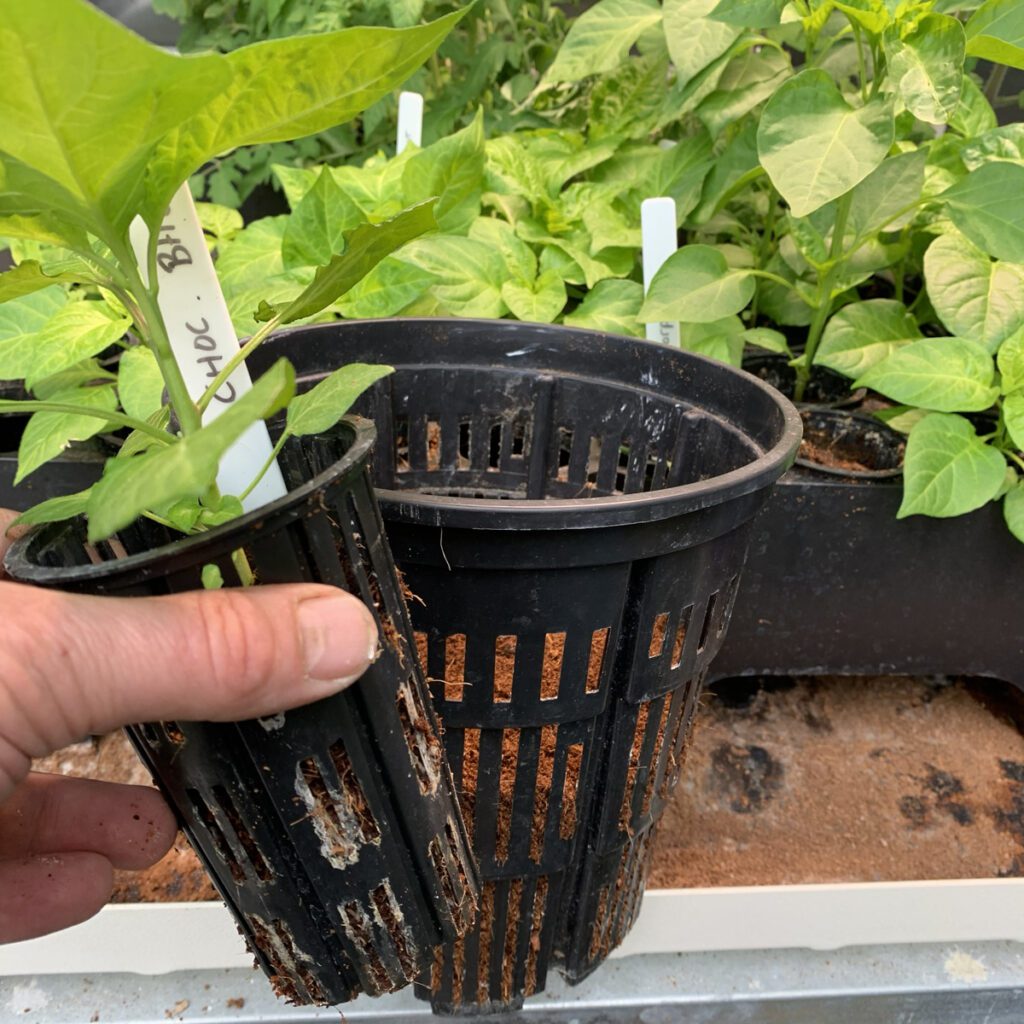
Potting hot peppers into RediRoot aeration pots
Hydroponic Bucket: A 5 gallon HydroBucket DWC set up easily supports a four to six foot tall hydroponic hot pepper plant, requiring only top ups and pH checks every day or two–very easy and productive with no worries of leaks or power outages.
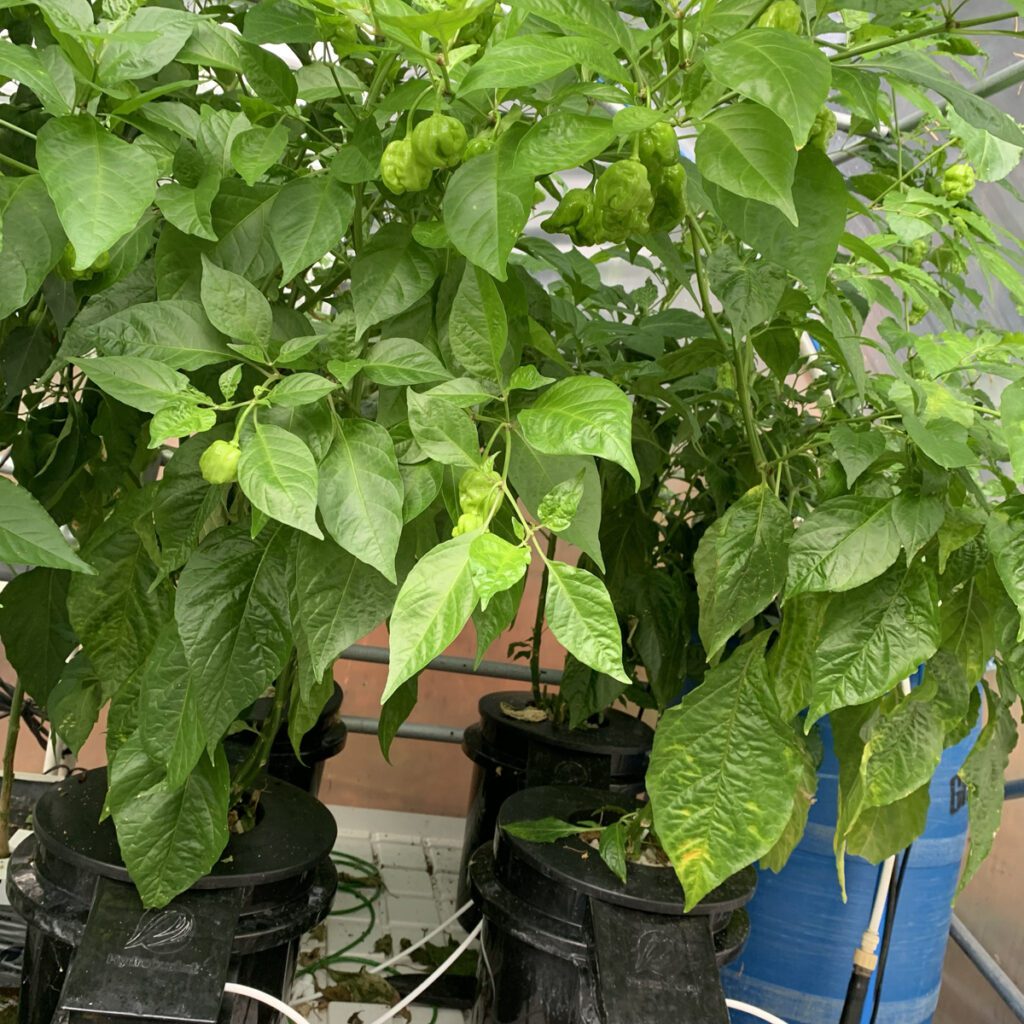
5 gallon HydroBuckets supporting aggressive growth and fruiting
Professional RDWC System: a professional RDWC system like the UnderCurrent using 8 gallon or 13 gallon grow modules can produce some HUGE plants loaded with extra large fruits, around nine feet and twelve feet tall and around, respectively. We wouldn’t expect plants that come from a a package that states “three feet tall” to reach these types of statures. However, we discovered in a supercharged RDWC system they can hit these sizes in a typical growing season in our greenhouse.
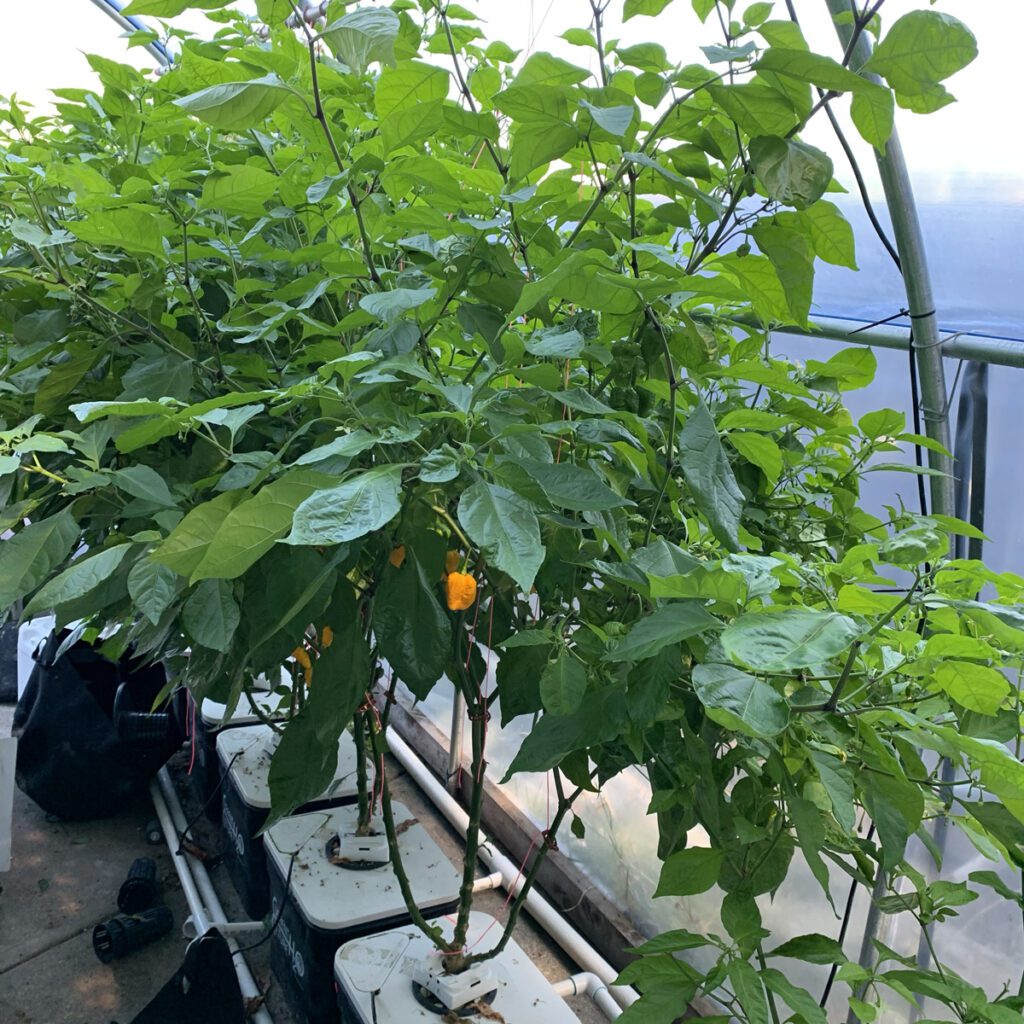
professional level RDWC system stimulating huge hot pepper plants–almost out of room. NOTE greenhouse cross tie is six feet above grade
Optimal Environment for Growing Hydroponic Hot Peppers
If you are growing your hydroponic hot peppers on your patio, balcony, sunny window or backyard you won’t have a high degree of environmental control, although outdoors you can extend the growing season with row covers or cloches. Don’t fret; if you get an early start seeding indoors, ie January or February and have a hot summer, there’s a good bet you’ll harvest loads of hydroponic hot peppers before the first kill frost or scarcity of sunlight begins.
In a greenhouse or indoors under grow lights like LEDs it’s possible to manipulate the growing environment using equipment like fans, humidifiers and even supplemental carbon dioxide to create the perfect environment in each growth phase before harvest.
In short, hot peppers thrive in hot conditions–they just LOVE hot summer days, provided they have lots of clean water to drink, adequate nutrition and oxygen at the roots; a snap in a good hydro set-up!
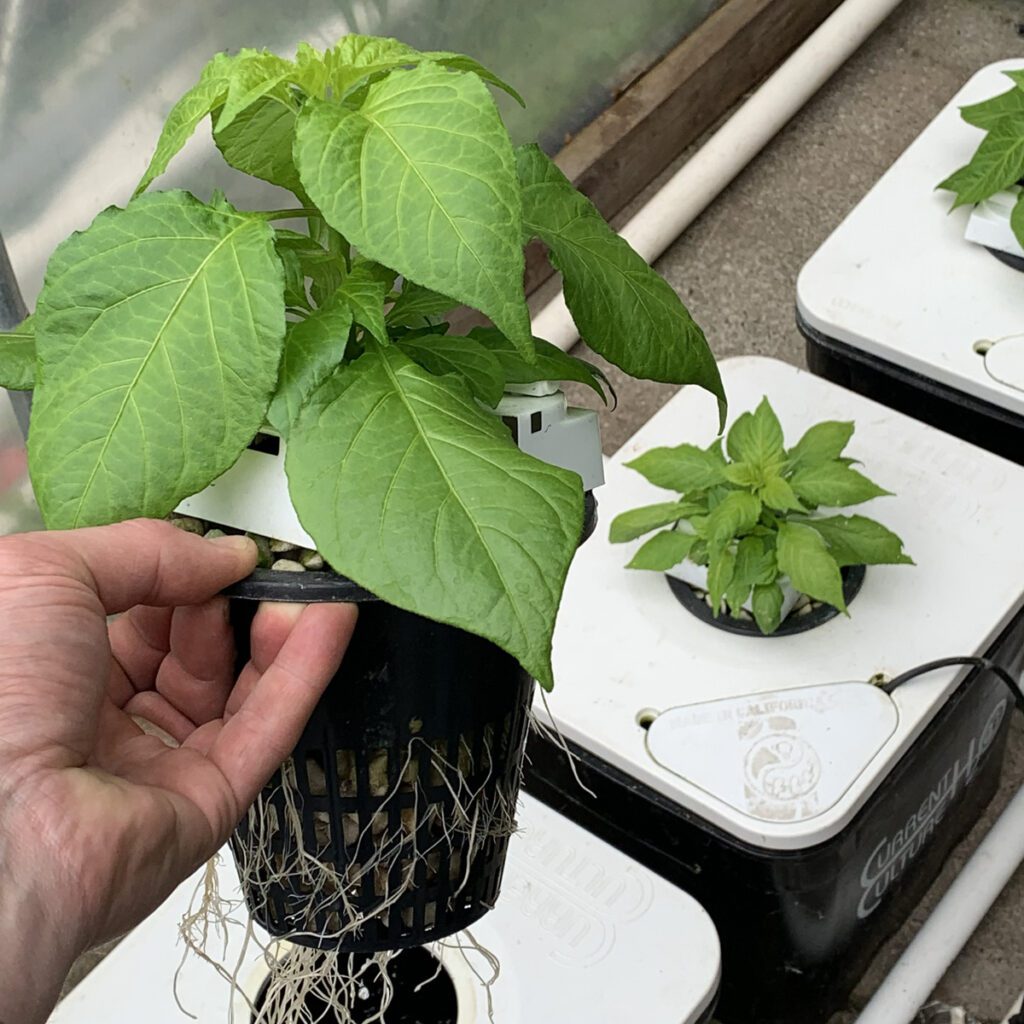
maintaining a steady environment in early growth helps ensure healthy harvests later on
Humidity
They however, do not like the air too dry or too humid, especially in early flowering. When flowers are forming and pollination is occurring, do your best to ensure the plants are maintained in a ranger of 60-70% Relative Humidity. In veg and later flowering, they will tolerate a wider range. As a rule of thumb, growers maintain higher humidity levels in early growth and gradually work the crop towards drier air once fruits have formed and begin ripening.
If the air is too moist, growth is stifled as plants cannot give up excess moisture through the leaves easily. If the air is too dry, plants struggle to stay hydrated and may show signs of stress, for example foliage may “taco”. Fortunately, hydroponics keep plants hydrated and amped up, so they can tolerate hot and dry conditions with ease in most instances.
Air Temperature
All of the hot pepper varieties we have grown, once established to good stature, thrived in temperatures beyond comfortable for most people. For early vegetative development 75 to 85 DegF is a good temperature range to maintain, gradually ramping up to 85 DegF during light hours. This is also a good temperature range to maintain during early flowering, when plants are most sensitive to the environment; it pays to baby them here. Once fruits begin to set in the canopy, plants thrived in hot temperatures, even well beyond 85 DegF.
Root Temperature
Roots typically do not like very warm temperatures, for example beyond 75 DegF. Hot peppers do tolerate warmer conditions at the roots in hydroponics when the nutrient solution is kept clean and free of organic components. During very high day time temperatures in water culture systems be very diligent with hydroponic system hygiene. Additions of Hypochlorous Acid are perfectly food safe and help keep unwanted microbes, biofilms and other vectors from infecting root systems under warm conditions. Plenty of aeration or drainage at the roots is always beneficial in warm conditions.
TIP: it is more efficient to heat or cool hydroponic nutrient solutions than trying to heat or cool the air–thermodynamics is your friend, since the plant is 90% water. For example, in early season greenhouse growing use aquarium heaters in hydroponic systems to keep a steady 72 DegF and keep the air cooler to save on power.
Carbon Dioxide
Serious indoor or greenhouse growers may supplement and manage carbon dioxide levels in the aerial growing environment. Typically starting at 600 PPM and working all the way up to 1200PPM and backing off at ripening to 800 PPM or less
In our next instalment we will discuss crop management techniques like irrigation, pruning, preventative maintenance, ripening & harvesting, so please stay tuned!
The post Hydroponic Hot Peppers Part Two appeared first on GROZINE.
Underground Dispensary
Author: Erik Biksa


